Notable BC Freshwater Fish
Notable freshwater fish
Some of the fish species found in BC are detailed in the table below.
Steelhead (oncorhynchus mykiss)
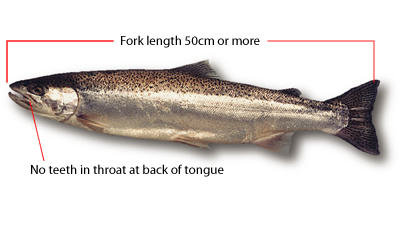
Typical range in length for adults: 50-85cm Maximum: 120cm
Typical range in weight for adults: 1.4-6.8kg Maximum: 21kg
Steelhead are considered a variant of freshwater rainbow trout yet, like salmon, spend a portion of their life cycle in the ocean. The rich marine environment gives rise to individuals that can weigh as much as 18 kg. Unlike salmon, steelhead may spawn multiple times over a lifespan of approximately nine years. In 2018, citing dramatically reduced spawning returns, the Committee on the Status of Endangered Wildlife in Canada (COSEWIC) categorised Thompson River and Chilcotin River steelhead populations as Endangered. Recognising risks to steelhead populations, the province has regulated catch and release only fisheries for steelheads since 1997. The province continues to actively management population recovery efforts by closing Interior steelhead runs and associated spawning grounds to recreational fishing.
Maintaining the ‘wild and sustainable’ brand for BC steelhead fisheries remains the highest priority for this species’ management and is fundamental to its continued value and appeal. In recent decades, ocean survival of steelhead, particular those populations in the Fraser River watershed have declined significantly. Limited augmentation of stock through hatchery programs has been undertaken to support recreational fishing opportunities. While some yearly and regional variability in fish returns is a normal factor in managing a wild fish population, the persistently depressed state of numerous steelhead stocks warrants further examination. At a provincial level a framework has been developed to guide steelhead management while enabling regional programs to evolve to address local conditions and concerns.
Provincial Framework for Steelhead Management in BC [PDF 420 KB]
Steelhead Stream Classification Policy [PDF 80 KB]
Chinook (Oncorhynchus tshawytscha)
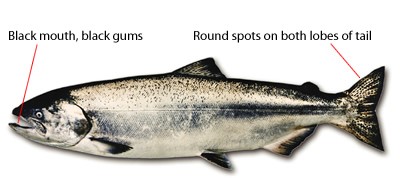
Typical range in length for adults: 61 to 91 cm Maximum: 150cm
Typical range in weight for adults: 4.5 to 22.7kg Maximum: 57kg
Chum (Oncorhynchus keta)
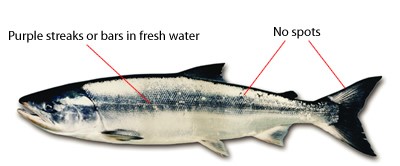
Typical range in length for adults: 60 to 70cm Maximum: 112cm
Typical range in weight for adults: 4.4 to 10.0kg Maximum:19kg
Coho Salmon (Oncorhynchus kisutch)
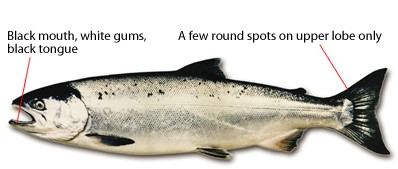
Typical range in length for adults: 56 to 66cm Maximum: 110cm
Typical range in weight for adults: 3.2 to 5.0kg Maximum:16kg
Pink Salmon (Oncorhynchus gorbuscha)
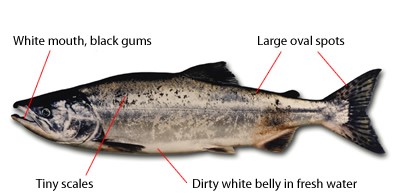
Typical range in length for adults: 36 to 46cm Maximum: 76cm
Typical range in weight for adults: 1.5 to 5kg Maximum:6.8kg
Sockeye (Oncorhynchus nerka)
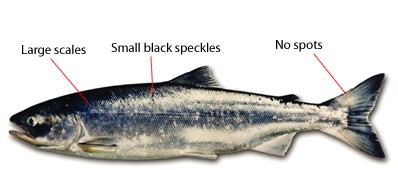
Typical range in length for adults: 60 to 75cm Maximum: 80cm
Typical range in weight for adults: 2.3 to 7kg Maximum: 8kg
The management of salmon fisheries in B.C., in both tidal and fresh waters, is the responsibility of Fisheries and Oceans Canada (DFO). The regulations for salmon fishing in fresh water are available from any DFO Office or through their website. To fish for salmon in fresh water, a provincial Non-Tidal Angling Licence is required. To retain any salmon caught in fresh water, your provincial Non-Tidal Angling Licence must be validated with a Non-Tidal Salmon Conservation Stamp.
While direct management of wild salmon saltwater and fresh water fisheries falls under the mandate of Fisheries and Oceans Canada (DFO), British Columbia has significant social and economic interests in, as well as key responsibilities for habitat management for all five species of Pacific Salmon. Specific populations of Chinook, Sockeye and Coho salmon have been categorised by the Committee on the Status of Endangered Wildlife in Canada (COSEWIC) at varying levels of concern from Not at Risk to Endangered although no populations have yet been designated under the Species at Risk Act.
In 2018, the Province established the Wild Salmon Advisory Committee (WSAC) to develop management options and undertake community consultations on strategies aimed at recovering salmon populations and addressing related community economic factors. The WSAC delivered its recommendations to the Province in February 2019, focused on three key objectives:
- Restoration and enhancement of wild salmon populations;
- Sustainable fisheries management and stewardship opportunities for communities; and
- New economic development opportunities to assist viable and sustainable community-based fisheries.
White Sturgeon (Acipenser transmontanus)
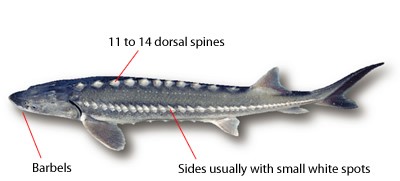
Typical range in length for adults: 1.6 to 2.1m Maximum: 6.1m
Typical range in weight for adults: 7 to 700kg Maximum: 820kg
Life History:
Egg/embryo: White Sturgeon spawn May-July and eggs hatch quickly (<14 days); the early yolk sac stage is when there is some downstream drift and hiding in interstitial spaces or off-channel habitat for about 12 days. From 12 to 40 days after hatch strugeon larvae begin feeding and further dispersal occurs with nocturnal activity.
Early Juvenile: at 40 days sturgeon resemble a White Sturgeon and for the next year have limited movement and prefer low velocity refuge including off channel habitat.
Juvenile/Subadult/Adult (~2 years to 20 years): as sturgeon grow they can utilize a broader range of habitats and cover hundreds of kilometers in a year as they become adults. Although they use a range of habitats there is a link to deeper river holes as holding and over winter habitats.
Spawning Adult: males become sexually mature before females, as young as 11 years for males and 25 years for females and this is when they are approximately 160 cm in fork length. Females spawn every 2 to 7 years (on average every 4 years); males spawn more often.
NOTE: Have you spotted a dead sturgeon? Report a dead sturgeon sighting within British Columbia. Reporting a find will help biologists track and investigate the carcass. Information can be entered on the website, including a map location and photos. Please do not move the carcass.
General:
White Sturgeon are cartilaginous fish adapted to living in fast-moving waters of larger rivers, notably the Fraser, Columbia and Nechako although they do range to the ocean environment. An ancient species, white sturgeon are both long-lived (over 100 years) and large (growing up to six metres and 800 kg). Despite their longevity, populations have been impacted by loss of habitat, dam construction and water regulation on key river systems, harvest pressure on prey species, introduction of invasive species, chemical pollution from upland run-off and both targeted and indirect harvesting impacts. In 2006, the Nechako, Upper Fraser, Upper Columbia and Kootenay populations were listed as Endangered under the Species at Risk Act. For more information see DFO Species at Risk Action Plan.
Active recovery efforts for the Columbia, Kootenay and Nechako populations are being coordinated by technical and community working groups. The working groups include provincial and federal agencies, First Nations, local government, community and non-governmental organizations, industry partners and others.
Though endangered, white sturgeon populations in the Lower and Middle Fraser River are considered healthy enough to support world class catch and release fisheries. Fish that are more than 3 m in length and over 150 kgs in weight are regularly caught each year. The majority of white sturgeon populations in British Columbia are listed under the federal Species at Risk Act and are not open to angling. As white sturgeon mature after 17 to 20 years and can live for more than 100 years, impacts or injuries can be long lasting. As such, all sturgeon angling in the province is catch and release only, and anglers must take special care to treat fish gently during capture and release. Please review the document Releasing White Sturgeon - The Gentle Way (PDF, 44KB)to ensure that you catch and release white sturgeon with minimal harm, to help maintain this amazing fishery and to allow these gentle giants of the Fraser to live another day.
Further information about B.C. and transboundary white sturgeon:
- COSEWIC Assessment and Status Report on White Sturgeon (PDF, 2MB)
- White Sturgeon Recovery Strategy (PDF, 49.1MB)
- Nechako White Sturgeon Recovery Initiative
- BC Fraser River White Sturgeon Plan
- Columbia River White Sturgeon Recovery
- Kootenay White Sturgeon
- Fish Between the Falls (PBS Documentary - Video)
Kokanee (Oncorhynchus nerka)
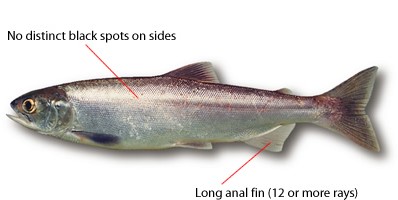
Typical range in length for adults: 20 to 35cm Maximum: 60cm
Typical range in weight for adults: 0.1 to 0.5kg Maximum: 4.5kg
Kokanee are a freshwater form of the sockeye salmon. Like salmon, kokanee die after spawning. Kokanee are considerably smaller than their anadromous relatives with an average length of approximately 30 cm and a mass of 0.45 kg. Despite their close connection, the two species do not appear to interbreed, even when they spawn in the same streams. They are nevertheless a favourite target for recreational anglers
Westslope cutthroat trout (Oncorhynchus clarkii lewisi)
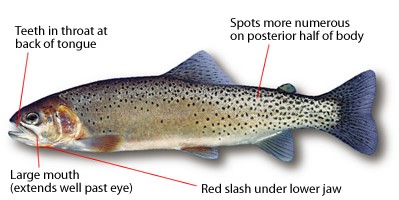
Typical range in length for adults: 15 to 25cm Maximum: 46cm
Typical range in weight for adults: 0.03 to .15kg Maximum: 1.5kg
Westslope cutthroat trout are native to British Columbia. These fish are relatively small, typically about 40 cm in length. In southern and eastern parts of the province habitat loss, resource extraction and hybridization with introduced rainbow trout have resulted in significantly depleted populations. More recently, the arrival of Whirling Disease in its habitat has caused additional concerns. In response to these pressures, westslope cutthroat trout are identified in provincial fishing regulations for catch and release through much of their range, primarily on smaller tributaries. In 2016, the Committee on the Status of Endangered Species in Canada (COSEWIC) categorised the westslope cutthroat trout as a population of Special Concern. Fortunately the Kootenay River watershed continues to support numerous, healthy populations. Due to their preference for cold, clear water with cover (undercut banks, riparian vegetation, etc., westslope cutthroat trout are often the only native species within their range.
Coastal cutthroat trout (Oncorhynchus clarkii clarkii)
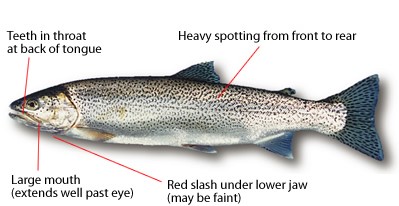
Typical range in length for adults: 35 to 55cm Maximum: 76cm
Typical range in weight for adults: 0.9 to 2.3kg searun 11 to 91g stream-resident Maximum: 8kg
Coastal cutthroat trout demonstrate three different lifecycles. Residents may establish a territory in or near their natal stream and remain there for their entire lives. Others may migrate from natal stream to larger freshwater bodies while a third variation migrates to saltwater during winter months to feed prior to returning to freshwater. In all cases, coastal cutthroat trout return to their natal stream to spawn. With a lifespan of up to 10 years, cutthroat trout have the potential to spawn repeatedly although pressure from predators and anglers typically limits spawning events to two on average.
Bull Trout (Salvelinus confluentus)
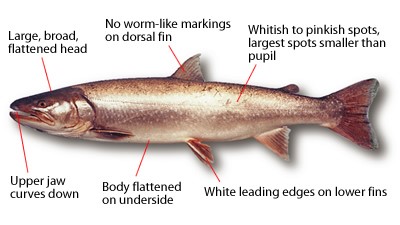
Typical range in length for adults: 25 to 90cm Maximum: 115cm
Typical range in weight for adults: 1 to 2.5kg Maximum: 14.5kg
The bull trout follows four distinct life history strategies including, stream resident, river migration, lake migration and ocean migration. Their sizes and lengths vary significantly depending on the life history with anadromous bull trout being hte largest. Cold, clear water is the defining quality of bull trout habitat, along with snags and overhanging banks which benefit their ambush hunting tactics. The coastal anadromous bull trout populations have been designated as species of special concern by COSEWIC.
Dolly Varden (Salvelinus malma)
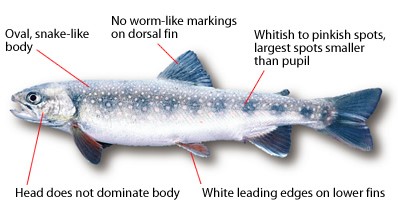
Typical range in length for adults: 30 to 40cm Maximum: 112cm
Typical range in weight for adults: 0.5 to 1.8kg Maximum: 8.7kg
The Dolly Varden was only recognized as a distinct species from the bull trout in 1978. In northern portions of the province it may also be confused with the Arctic Char. Dolly Vardens exhibit a range of different life history strategies from those that live their entire lives in small streams to ones that migrate to larger streams or lakes on to anadromous fish that migrate to the ocean. This range of life histories is known to exist within the same river basin and even within the same populations. . The size and weight of typical Dolly Vardens varies largely according to life history, with those migrating to the ocean demonstrating the greatest size.
Rainbow trout (Oncorhynchus mykiss)
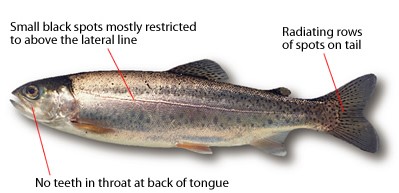
Typical range in length for adults: 30 to 75cm Maximum: 90cm
Typical range in weight for adults: 1 to 7kg Maximum: 9kg
Rainbow trout represent the majority of fish stocked in BC lakes and rivers. Sterile and single gender stocking ensures that these fish do not interbred with native populations or establish home territories on their own. Rainbow trout demonstrate significant variation in form, ranging from the sea-run steelhead to the the massive "Gerrards" of Kootenay lake which, at 9kg, have a mass nearly four times that of more common rainbow trouts.
Arctic grayling (Thymallus arcticus)
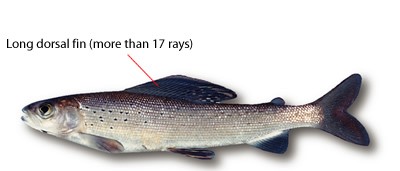
Typical range in length for adults: 15 to 50cm Maximum: 75cm
Typical range in weight for adults: 1 to 2kg Maximum: 2.7kg
Arctic grayling are one of the most colourful fish inhabiting British Columbian waters. Residents of northern river systems, primarily the Stikine and the Peace, Arctic graylings prefer the cold clear water of large rivers, rocky creeks and lakes. While the fish are doing well on a provincial scale, those populations located behind the WAC Bennett Dam are considered threatened as a result of habitat flooding and separation of populations.
Largemouth Bass (Micropterus salmoides)
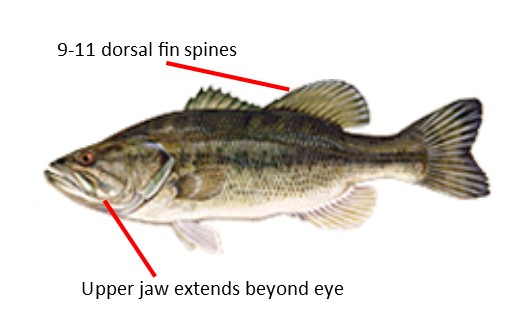
Typical range in length for adults: 25 to 55cm Maximum: 75cm
Typical range in weight for adults: 0.7 to 1.8kg Maximum: 11.4kg
Smallmouth Bass (Micropterus dolomieu)
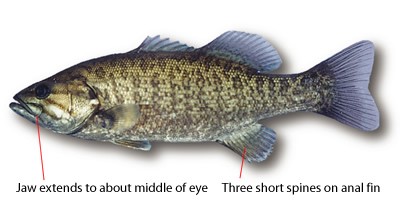
Typical range in length for adults: 25 to 50cm Maximum: 69cm
Typical range in weight for adults: 0.5 to 1.6kg Maximum: 5.5kg
Native to south and eastern parts of the United States, both the largemouth and smallmouth bass are highly regarded by anglers as spirited game fish that fight vigorously when hooked. Likely introduced for sport fishing purposes, large and small mouthed bass are aggressive hunters possessing unique qualities that enable them to successfully adapt to new habitat, frequently resulting in significant declines in native fish populations. The largemouth bass is known to harbour parasites which may further endanger native species. .
Yellow Perch (Perca flavescens)
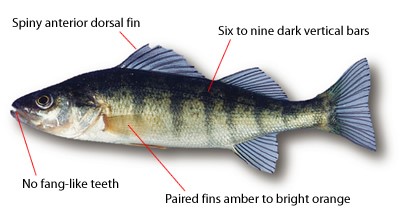
Typical range in length for adults: 15 to 30cm Maximum: 34cm
Typical range in weight for adults: 0.35kg Maximum: 0.7kg
Native to much of the eastern United States and Canada, Yellow Perch have been introduced into the Pend Oreille, Kootenay and Okanagan watersheds. An effective hunter, yellow perch compete with native salmon and trout for plankton and preys upon juveniles of other fish species. An assessment of its potential ecological impact in smaller water bodies yielded a high rating with a moderate impact rating in larger lakes.
Eastern brook trout (Salvelinus fontinalis)
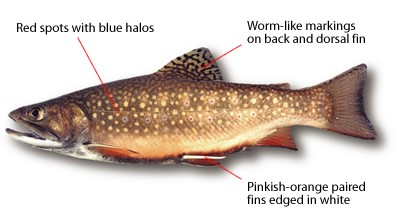
Typical range in length for adults: 25 to 65cm Maximum: 84cm
Typical range in weight for adults: 0.3 to 3.1kg Maximum: 6.6kg
Natives of the eastern province and states, Eastern brook trout or more accurately eastern brook char, were introduced to BC some time ago as a game fish. Preferring cooler water temperatures, eastern brook char will primarily be found in lakes and slower streams. Populations are maintained through active stocking programs, sterile females are stocked to ensure there is no risk of resident populations becoming established.
Burbot (ling) (Lota lota)
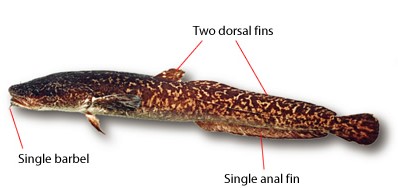
Typical range in length for adults: 30 to 75cm Maximum: 90cm
Typical range in weight for adults: 1 to 7kg Maximum: 9kg
The burbot has a long tapering body that reminds some of a ling cod (an unrelated saltwater fish). The burbot possess a single barbel on its chin and one at each nostril and is smooth and slippery to the touch due to a heavy mucous covering. The burbot is broadly distributed across the province, inhabiting lakes and rivers from the Columbia and Fraser to the Peace and Yukon. Interestingly, the burbot is one of the few fish in the province to spawn in mid-winter under the ice. The burbot favours cold, deep waters and has been caught from at depths as much as 210m. By contrast, juvenile burbots are more likely to be encountered in weedy areas and rocky shorelines. A fierce predator with a diverse appetite, the burbot is capable of swallowing prey nearly their own size. While the provincial population is considered healthy, in some areas notably on the Columbia and Kootenay Rivers, habitat changes as a result of dam construction have resulted in significantly reduced numbers.
Black Crappie (Pomoxis nigromaculatus)
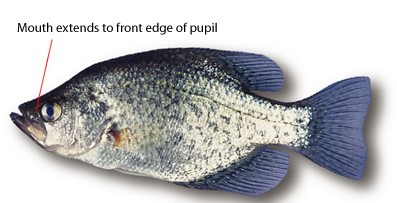
Typical range in length for adults: 10 to 20cm Maximum: 49cm
Typical range in weight for adults: 1 to 7kg Maximum: 9kg
The black crappie is a popular sport fish originally from eastern Canada and the United States but since transplanted widely. Reports of the black crappie in provincial waters date back to the 1930's and it has since been reported in systems linked to the lower Fraser, the Okanagan, and Kootenay Rivers. Black crappies prefer clear water with little current, submerged material and or weeds and muddy or sandy bottoms such as one might find in ponds and small lakes. In many provincial lakes where black crappies have been found native populations of small fish have largely disappeared although it is uncertain whether this is due to direct predation or competition for resources. Black crappies are prolific and populations can quickly grow to challenge the carrying capacity of their habitats. Black crappies are unusual among freshwater fish for their schooling behaviour.
Northern Pike (Esox lucius)
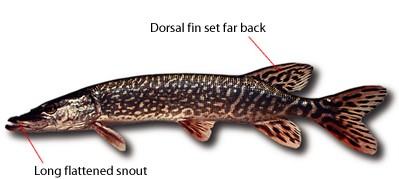
Typical range in length for adults: 40 to 55cm Maximum: 150cm
Typical range in weight for adults: 0.9 to 2.3kg Maximum: 21kg
As the name suggests, the northern pike are native to some of the more northerly river systems in the province, including the Yukon and Liard, although it has also been found in the Kootenay and Pend d'Oreille systems in southern BC as a result of unauthorized transplantation. Known as an aggressive predator, the northern pike favours ambush tactics, waiting motionless for extended periods then striking prey after a sudden burst of speed. For this reason, northern pike tend to favour the cover provided by vegetated or rocky areas. In southern BC, concerns have been raised that invasive pike could have significant impacts on salmon and kokanee populations.
Mountain Whitefish (Prosopium williamson)
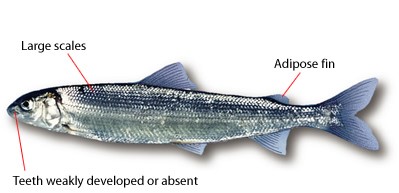
Typical range in length for adults: 15 to 25cm Maximum: 70cm
Typical range in weight for adults: 0.05 to 0.2kg Maximum: 2.9kg
The mountain whitefish favours cold deep lakes and swift running clear streams with deep pools. This fish is well distributed across the province and its population is considered secure. Interestingly, two different versions of the mountain whitefish have been identified in some populations, the typical example and a "pinocchio" version which possesses an elongated snout. It has been suggested that the longer snout may confer advantages for foraging as mountian whitefish are primarily bottom feeders. Researchers continue to study the whitefish to determine how the trait is inherited through only a portion of the population.
Lake Whitefish (Coregonus clupeaformis)
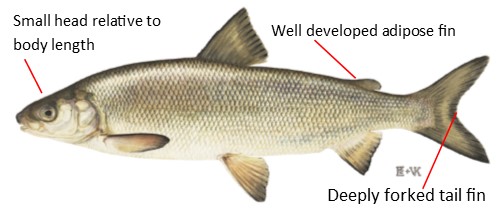
Typical range in length for adults: 30 to 65cm Maximum: 70cm
Typical range in weight for adults: 0.9 to 1.8kg Maximum: 7kg
The lake whitefish is most commonly found in cool deep lakes, primarily in northern and central BC. Lake whitefish were also introduced at some time in the past into the Kootenay and Okanagan drainages. Lake whitefish are primarily bottom feeders but move to shallower waters in the spring to feast on newly emerged insect larvae before returning to cooler deeper water to avoid the heat of summer. Spawning occurs in the fall in shallower water with the winter spent back in the depths. Lake whitefish are a prey species of burbot, lake trout and northern pike, thus playing a key role in the life cycles of these species.
Lake Trout (Salvelinus namaycush)
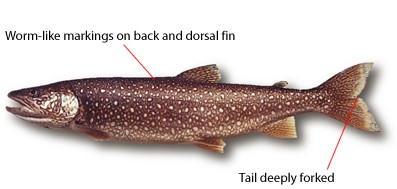
Typical range in length for adults: 60 to 90cm Maximum: 150cm
Typical range in weight for adults: 1 to 5kg Maximum: 33kg
Found in both deep and shallow lakes in the north, in the south, where stocks from eastern North America have been introduced, the lake trout seeks the cooler waters of deeper lakes. While most lake trout eat a variety of invertebrates, fish and even small mammals, some populations depend entirely on plankton.The lake trout is solitary by nature and may wander extensively within its habitat.The lake trout is known to be particularly sensitive to pollution, particularly insecticides.
Brown Trout (Salmo trutta)
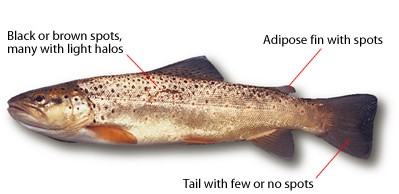
Typical range in length for adults: 20 to 60cm Maximum: 150cm
Typical range in weight for adults: 0.5 to 4.5kg Maximum: 25kg
A native of Europe and Asia, the brown trout was introduced for its qualities as a sport fish. It is now well established in several locations on Vancouer Island, in particular the Cowichan River, and in several river systems in Southern BC. Brown trout prefer overhanging cover in the form of undercut banks, submerged rocks or thick vegetation as well as cold, well oxygenated water. It can be susceptible to reduced oxygen availability. The brown trout displays a number of life strategies including river-based, lake-based and sea-run. Although brown trout do not necessarily die after spawning, survival rates are low particularly for males.
Walleye (Sander vitreus)
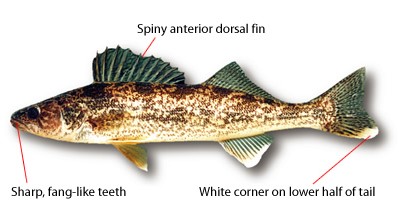
Typical range in length for adults: 35 to 60cm Maximum: 107cm
Typical range in weight for adults: 0.7 to 1.4kg Maximum: 11kg
The walleye is resident of streams and lakes in northeastern BC where it favours warm, shallow water with high turbidity. It's name walleye refers to the outward looking orientation of its eyes which gives it superior vision in low light conditions when it hunts for crayfish, minnows and other, typically juvenile, fish. At some time in the past, walleye were introduced into the Columbia River system where it appears they are now established.
Goldeye (Hiodon alosoides)
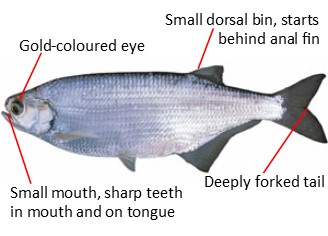
Typical range in length for adults: 30 to 40cm Maximum: 52cm
Typical range in weight for adults: 0.4 to 0.9kg Maximum: 1.7 kg
The goldeye has a limited distribution in BC, occurring only in portions of the Liard and Fort Nelson River systems. While these sightings may reflect migration from Alberta, the small number and limited distribution warrant additional attention. The goldeye favours the deeper waters of slow, turbid rivers and small lakes. It is a seasonal migrant, moving upstream in the spring before returning to mainstem rivers and lakes in the fall for overwintering. Primarily nocturnal, the gold eye feeds on insects, mollusks, small fish, frogs and small mammals,
Inconnu (Stenodus leucichthys)
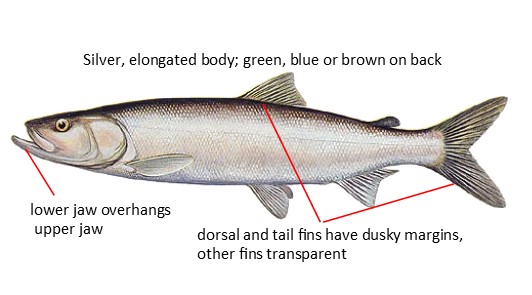
Typical range in length for adults: 30 to 100cm Maximum: 150cm
Typical range in weight for adults: 2 to 10kg Maximum: 40kg
The Inconnu is a northern whitefish, limited in BC to populations in Teslin Lake and within the Liard and Mackenzie River drainages. While inconnu are known to be anadromous, tagged individuals have travelled to the Arctic via the Mackenzie River and returned, some populations, such as those in Teslin Lake are believed to be resident in the lake year-round. The Liard River population migrates via the Yukon River system to the Bering Sea, many hundred kilometres from the Mackenzie Delta, which suggests that the two BC populations may be genetically distinct. Adult inconnu are fish eaters while juveniles may feed on insect larvae and planktonic crustaceans. Additional research is required to better understand the nature of these populations in BC.
Signal Crayfish (Pacifastacus leniusculus)
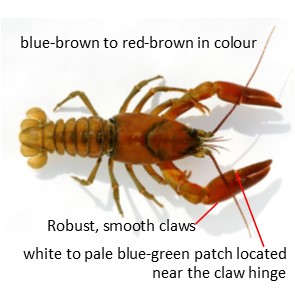
Typical range in length for adults: 6 to 15cm Maximum: 20cm
The signal crayfish is a solitary omnivore, eating a variety of food ranging from decomposing roots to meat, including smaller crayfish and fish. Typically found in smaller streams, rivers and lakes, juveniles favour rocky cobble substrate while adults tend towards silty or sandy bottoms where they can dig burrows the signal crayfish is cool temperature tolerant and may be found as high as the subalpine. In BC, it's range is generally limited to south of 51° north latitude. Although endemic to this region, it is believed to have been introduced to southern Vancouver Island due to the absence of records prior to 1900.
